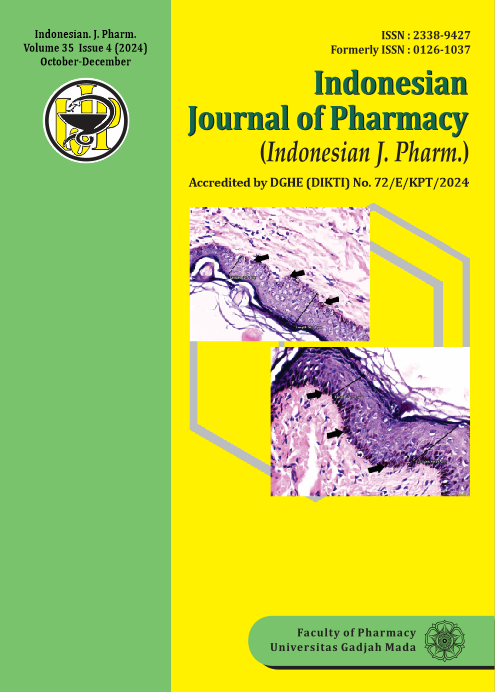A Survey on Medicine Shortage in Community Pharmacies in Yogyakarta Province, Indonesia
Abstract
Access to quality healthcare has been considered an apolitical objective on a global scale. Despite this, there are occasionally shortages of medicines because they are not always readily available. A drug supply problem that necessitates a change that affects patient care and requires the use of an alternative agent is known as a medicine shortage. A shortage can occur at any point during a medicine's lifecycle and in any part of the pharmaceutical distribution chain (pharmacy, pharmaceutical company, or wholesaler). This research aims to evaluate the availability of medications in pharmacies in Special Region of Yogyakarta. A cross-sectional survey was conducted in 120 pharmacies in Yogyakarta province, during March to May 2022. WHO essential medicine indicators were used to observe the list of medicine shortage, and its characteristics, including the reasons for medicine shortages in pharmacies, classification of unavailable drugs, and the consequences of medicine shortages. Data were presented descriptively. There were 650 drug items (a total of 1560 items) in one month that were unavailable at 91 pharmacies (75.83%) at least once every six months. The active ingredients that are in short supply are atorvastatin (44.17%), diazepam (21%), azythromycin (13.33%), and haloperidol (13.21%). The medications that were in high demand were also the ones that were in short supply. The reasons for the medicine shortages were rarely communicated to the pharmacies. Customers were able to fill their prescriptions since there were usually enough alternatives. But every third time, there were problems at the pharmacy because there weren't enough medicines. Due to the potential for unhappy customers and increased workload for the pharmacy staff, these shortages may be significant for both the customer and the pharmacy.
References
AL-hawawsheh, B. (2019). Impact of Pharmaceutical Supply Chain Factors Effectiveness on Drug Availability in Public Hospitals. Journal of Management Policies and Practices, 7(2). https://doi.org/10.15640/JMPP.V7N2A3
American Hospital Association. (2011). Report: AHA Survey on Drug Shortages | AHA. American Hospital Association. https://www.aha.org/guidesreports/2011-07-11-report-aha-survey-drug-shortages-0
American Society of Health-System Pharmacists. (2021). Virtual Summit on Safe, Effective, and Accessible High-Quality Medicines as a Matter of National Security. American Journal of Health-System Pharmacy, 78(6), 511–520. https://doi.org/10.1093/AJHP/ZXAA392
Atif, M., Malik, I., Mushtaq, I., & Asghar, S. (2019). Medicines shortages in Pakistan: a qualitative study to explore current situation, reasons and possible solutions to overcome the barriers. BMJ Open, 9(9), e027028. https://doi.org/10.1136/BMJOPEN-2018-027028
Atif, M., Sehar, A., Malik, I., Mushtaq, I., Ahmad, N., & Babar, Z. U. D. (2021). What impact does medicines shortages have on patients? A qualitative study exploring patients’ experience and views of healthcare professionals. BMC Health Services Research, 21(1), 1–13. https://doi.org/10.1186/S12913-021-06812-7/TABLES/4
Batista, A., Miljković, N., Polidori, P., & Kohl, S. (2019). Medicines shortages. European Journal of Hospital Pharmacy, 26(5), 290. https://doi.org/10.1136/EJHPHARM-2019-001911
Blankart, K. E., & Felder, S. (2022). Do Medicine Shortages Reduce Access and Increase Pharmaceutical Expenditure? A Retrospective Analysis of Switzerland 2015-2020. Value in Health, 25(7), 1124–1132. https://doi.org/10.1016/J.JVAL.2021.12.017
Bocquet, F., Degrassat-Théas, A., Peigné, J., & Paubel, P. (2017). The new regulatory tools of the 2016 Health Law to fight drug shortages in France. Health Policy (Amsterdam, Netherlands), 121(5), 471–476. https://doi.org/10.1016/J.HEALTHPOL.2017.03.007
Cahaya, N., Pramestutie, H. R., Hati, A. K., Untari, E. K., & Utami, P. (2022). Insurance, Policy, Knowledge Level and Epidemiology As Factors Affecting Demand And Supply of Pharmaceutical Product. Pharmaceutical Journal of Indonesia, 7(2), 79–88. https://pji.ub.ac.id/index.php/pji/article/view/759
de Weerdt, E., Simoens, S., Hombroeckx, L., Casteels, M., & Huys, I. (2015). Causes of drug shortages in the legal pharmaceutical framework. Regulatory Toxicology and Pharmacology : RTP, 71(2), 251–258. https://doi.org/10.1016/J.YRTPH.2015.01.005
Heiskanen, K., Ahonen, R., Karttunen, P., Kanerva, R., & Timonen, J. (2015). Medicine shortages--a study of community pharmacies in Finland. Health Policy (Amsterdam, Netherlands), 119(2), 232–238. https://doi.org/10.1016/J.HEALTHPOL.2014.11.001
Kanda, M. K., & Iravo, M. A. (2015). Access Factors Affecting Supply Chain Efficiency of Medical Supplies in public Health Centres in kenya: A Case Study of Public Health Centres in Elgeyo Marakwet Count. International Journal of Academic Research in Accounting, Finance and Management Sciences, 5(2), 32–41. https://ideas.repec.org/a/hur/ijaraf/v5y2015i2p32-41.html
Martha Wangu, M., & Onyango Osuga, B. (2014). Availability of essential medicines in public hospitals: A study of selected public hospitals in Nakuru County, Kenya. 8(17), 438–442. https://doi.org/10.5897/AJPP2014.4000
Pharmacists Association, C. (2010). Drug Shortages Survey - Final Report. Canadian Pharmacist Association.
Phuong, J. M., Penm, J., Chaar, B., Oldfield, L. D., & Moles, R. (2019). The impacts of medication shortages on patient outcomes: A scoping review. PLOS ONE, 14(5), e0215837. https://doi.org/10.1371/JOURNAL.PONE.0215837
Raikabakaba, A., Mohammadnezhad, M., Tamani, L., & Gaundan, D. (2022). Drug Shortages and Its Effects on Service Delivery among Key Informants (KIs) in Fiji. Global Journal of Health Science, 14(5), 1. https://doi.org/10.5539/GJHS.V14N5P1
Shukar, S., Zahoor, F., Hayat, K., Saeed, A., Gillani, A. H., Omer, S., Hu, S., Babar, Z. U. D., Fang, Y., & Yang, C. (2021). Drug Shortage: Causes, Impact, and Mitigation Strategies. Frontiers in Pharmacology, 12. https://doi.org/10.3389/FPHAR.2021.693426
Think Tank | European Parliament. (2020). Medicine shortage in the EU during the novel coronavirus outbreak. Think Tank | European Parliament. https://www.europarl.europa.eu/thinktank/en/document/IPOL_BRI(2020)652709
Tucker, E. L., Cao, Y., Fox, E. R., & Sweet, B. v. (2020). The Drug Shortage Era: A Scoping Review of the Literature 2001-2019. Clinical Pharmacology and Therapeutics, 108(6), 1150–1155. https://doi.org/10.1002/CPT.1934
Turbucz, B., Major, M., Zelko, R., & Hanko, B. (2022). Proposal for Handling of Medicine Shortages Based on a Comparison of Retrospective Risk Analysis. International Journal of Environmental Research and Public Health 2022, Vol. 19, Page 4102, 19(7), 4102. https://doi.org/10.3390/IJERPH19074102
Vyas, M., de Vries, E. G. E., Casali, P. G., & Tabernero, J. (2019). Shortages of inexpensive essential medicines. The Lancet. Oncology, 20(5), e224–e225. https://doi.org/10.1016/S1470-2045(19)30248-7
Woodcock, J., & Wosinska, M. (2013). Economic and technological drivers of generic sterile injectable drug shortages. Clinical Pharmacology and Therapeutics, 93(2), 170–176. https://doi.org/10.1038/CLPT.2012.220
Yang, C., Wu, L., Cai, W., Zhu, W., Shen, Q., Li, Z., & Fang, Y. (2016). Current Situation, Determinants, and Solutions to Drug Shortages in Shaanxi Province, China: A Qualitative Study. PLOS ONE, 11(10), e0165183. https://doi.org/10.1371/JOURNAL.PONE.0165183








